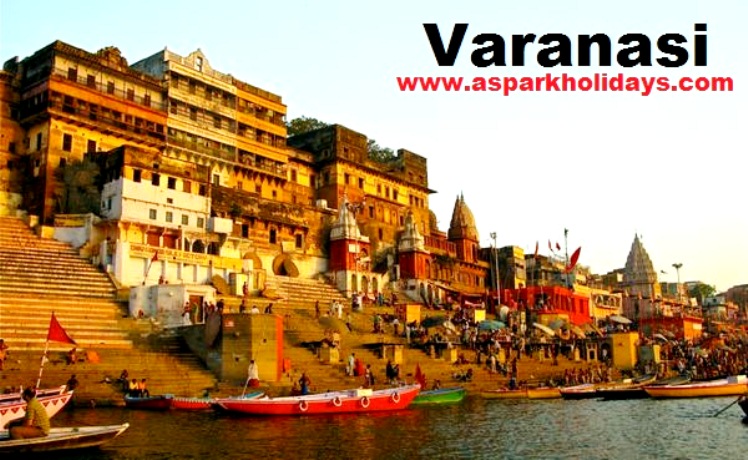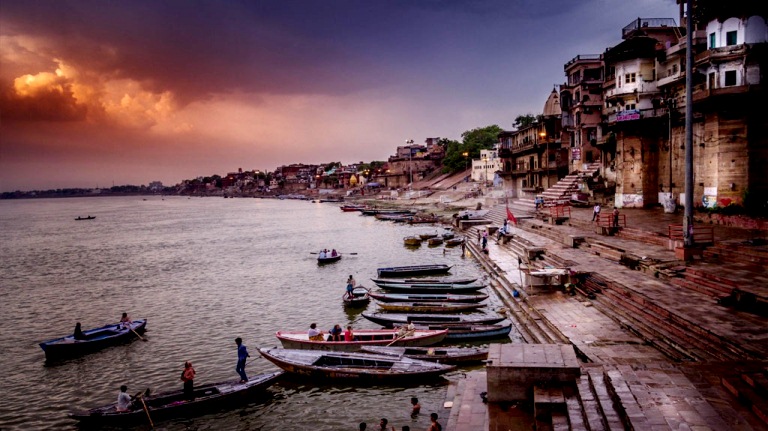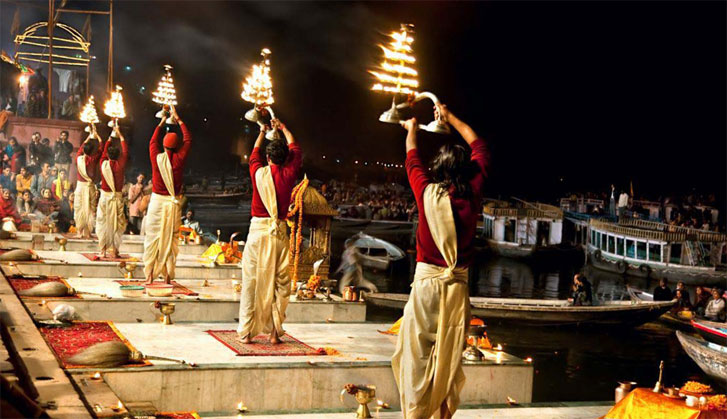
The land of Varanasi (Kashi) has been the ultimate pilgrimage spot for Hindus for ages. Often referred to as Benares, Varanasi is the oldest living city in the world. These few lines by Mark Twain say it all: "Benaras is older than history, older than tradition, older even than legend and looks twice as old as all of them put together". Hindus believe that one who is graced to die on the land of Varanasi would attain salvation and freedom from the cycle of birth and re-birth. Abode of Lord Shiva and Parvati, the origins of Varanasi are yet unknown. Ganges in Varanasi is believed to have the power to wash away the sins of mortals.
Ganges is said to have its origins in the tresses of Lord Shiva and in Varanasi, it expands to the mighty river that we know of. The city is a center of learning and civilization for over 3000 years. With Sarnath, the place where Buddha preached his first sermon after enlightenment, just 10 km away, Varanasi has been a symbol of Hindu renaissance. Knowledge, philosophy, culture, devotion to Gods, Indian arts and crafts have all flourished here for centuries. Also a pilgrimage place for Jains, Varanasi is believed to be the birthplace of Parsvanath, the twenty-third Tirthankar.
Vaishnavism and Shaivism have co-existed in Varanasi harmoniously. With a number of temples, Mrs. Annie Besant chose Varanasi as the home for her 'Theosophical Society' and Pandit Madan Mohan Malviya, to institute 'Benares Hindu University, the biggest University in Asia. Ayurveda is said to be originated at Varanasi and is believed to be the basis of modern medical sciences such as Plastic surgery, Cataract and Calculus operations. Maharshi Patanjali, the preceptor of Ayurveda and Yoga, was also affiliated with Varanasi, the holy city. Varanasi is also famous for its trade and commerce, especially for the finest silks and gold and silver brocades, since the early days.
Varanasi has also been a great center of learning for ages. Varanasi is associated with promotion of spiritualism, mysticism, Sanskrit, yoga and Hindi language and honored authors such as the ever-famous novelist Prem Chand and Tulsi Das, the famous saint-poet who wrote Ram Charit Manas. Aptly called as the cultural capital of India, Varanasi has provided the right platform for all cultural activities to flourish. Many exponents of dance and music have come from Varanasi. Ravi Shankar, the internationally renowned Sitar maestro and Ustad Bismillah Khan, (the famous Shehnai player) are all sons of the blessed city or have lived here for major part of their lives.
Places To Visit In Varanasi
THE KASHI VISHWANATH TEMPLE- Also known as the Golden Temple, it is dedicated to Lord shiva, the presiding deity of the city. Varanasi is Said to be the point at which the first jyotirlinga, the fiery pillar of light by which shiva manifested has supremacy over others gods, broke through the Earth crust and flared towards the heavens. More than the Gaths and even the Ganga, the Shivalinga installed in the temple remains the devotional focus of Varanasi.
BANARAS HINDU UNIVERSITY- Banaras Hindu University (B.H.U) founded by Pandit Madan Mohan Malviya in 1917A.D is the largest residential University in India. At the entrance, there is the grand statue of its founder and the Vishwanath temple in its centre. The huge temple was built in 1966, under patronage of the Birlas. It has a 677 meter high rising white top and its well carved architecture attracts pilgrims.
BHARAT KALA BHAWAN (ART MUSEUM)- In the cool and calm surroundings of B.H.U is the Bharat Kala Bhavan which has established in 1920A.D and has a vast collection of paintings, Hindu and Buddhist sculptures and other materials of archeological studies. In the main hall of the Bhawan, there is a figure of a man standing on one leg and one hand on his hip and lifting a mass of stone above his head, with one hand. The figure is said to be of Lord Krishna lifting Govardana. In the halls of the Bharat Kala Bhawan, there are many rare images that testify to the existence of Krishna cult in Kashi in 15th and 16th century Gupta period. It has the miniature paintings from the courts of Mughals and the Hindu Princes of Punjab Hills. Visit : Monday to Saturday . Opens from 1030 to 1600.
RIVER FRONT (GHATS)- The spectacular 4 km sweep of the Ghats is unique sight, best viewed at dawn, in that "soft first light" when the river and Ghats have a timeless appeal. Life is almost panoramic detail unfolds here from dawn to dusk as a steady stream of devotees-swelling to thousands on auspicious days perform rituals by the Ganga. The Ghats are best approached by Dashashwamedha ghat, where boats are available on hire.
DURGA TEMPLE- godess durga is considered as the goddess of Strength and Power. This temple was built in the 18th century with red stone work. A fine example of Nagara art. This temple falls on the main route from Railway Station to BHU, just before Tulsi Manas temple and Sankatmochan temple.
TULSI MANAS TEMPLETulsi Manas Mandir-Durgakund- Constructed by family of Varanasi, this modern temple is dedicated to Lord Rama. It is situated at the place Where Tulisdas, the great medieval seer, lived and wrote the epic "Shri Ramcharitmanas", which narrates the life of Lord Rama, the hero of the Ramayana. Verses from Tulidas epic are inscribed on the walls. SANKATMOCHAN TEMPLE Lord Hanuman temple, who is known to be the 'Sankatmochak' is just 300 meters from Tulsi Manas Temple. It is an ancient temple considered as built by Goswami Tulsidas himself.
NEW VISHWANATH TEMPLE- Situated in the premises of Banaras Hindu University, a modern place of worship planned by Pandit Malviya and built by the Birlas. Open to all, irrespective of caste or creed.
MAHATMA GANDHI KASHI VIDYAPEETH- Kashi Vidyapeeth was set up in 1920 by Babu Shiv Prasad Gupta to provide alternate education arrangement discarding that of the British. It soon became a centre of natoinal education with Hindi as the medium of instruction. Acharya Narendradev, Babu Sampurnanand, Babu Sriprakash & many more Luminaries of the time have been associated with this institute.>MUSUEMS & ARTS GALLERIES Archaeological musuem Sarnath open 09:30 am.- 5 pm. Friday clossed. Ramnager fort musuem, open 10 am.-5 pm. Clossed on Friday. Bharat Kala Bhawan B.H.U. open 10:30 am.- 4 pm. Closed on Sundays & university holidays. Archaeological musuem, Sampurnanand Sanskrit University open 10 am. 5 pm. Closed on Sunday & university holidays.
BHARAT MATA TEMPLE- This Temple was inaugurated by Mahatma Gandhi in 1936 and houses one perfect relief Map of India carved out of marble. The Temple was gifted by the nationalists Babu Shiv Prasad Gupta (Barat Ratana ) and shri Durga Prasad Khatri, leading numismatists and antiquarians. It is inside the premises of Kashi Vidyapeeth.
ASHOKA PILLAR- Ashoka Piller-Sarnath It is at Saranath, 10km north of Varanasi. Sarnath, the place where Buddha gave his first sermon is a popular Buddhist pilgrimage centre. The Ashoka pillar stands in front of the main stupa where Ashoka sat and meditated. The Sarnath Archaeological Museum at Ashoka Marg, houses a copy of Ashoka's lion pillar and some sculptures.
RAMNAGAR FORT- The residential place of Kashi Naresh (Former Maharaja of Varanasi) across the Ganges at Ramnagar houses a museum with the exhibits of palanquins, costumes, swords, sabres, etc. Dussehra celebration of Ramnagar is an interesting event to witness.14 km. from Varanasi. The fort at Ramnagar houses a museum displaying the Royal collection which includes vintage cars, Royal palkies, an armoury of swords and old guns, ivory work and antique clock. The Durga Temple and Chhinnamastika Temple are also located at Ramnagar. Ramnagar Fort which was built in 1750A.D by the Maharaja of Banaras, is on the right bank of River Ganga. Built of red stones, it provides strength and stability to the city. Visit : Daily from 0900 t0 1200 and 1400 - 1500. It is the residential palace of the former Maharaja of Varanasi. The palace is an astronomical and astrological wonder. Inside the giant walls of the palace, there is a big clock. Besides showing year, month, week and day, it baffles the onlooker with astronomy of the sun, moon and constellation of stars. This wonder clock or Dharam Ghari was made by the court astronomer of Banaras in 1852A.D. The palace has a temple dedicated to Ved Vyas and a museum set up by the last Maharaja of Banaras, Vibhuti Narain Singh. The museum has a collection of brocade costumes, palanquins, weapons and has expensive coaches made of ivory. The palace is decorated majestically and it vibrates with colour and life, during Dussehra festival. The celebrations comes to an end on Vijayadashmi, when the huge effigies of demon king Ravana and his kinsmen are sent up in flames, signifying the victory of good over evil.
ALAMGIR MOSQUE- An amalgmation of Hindu-Muslim religious sentiments, this mosque is also known as " Beni Madhav ka Darera". Curiously, the entire lower portion of the mosque is retained as a Hindu temple.
CENTRAL INSTITUTE OF HIGHER TIBETAN STUDIES- The only institute of its kind in the world, , imparting education in the Tibetan language, it was Est. by the Dalai Lama in 1971. Presently located at Sarnath. The institute has a rare collection of Buddhist texts, Tibetan manuscripts and other journals.
JANTAR MANTAR- Jantar Mantar is an observatory, built by Jai Singh, the Maharaja of Jaipur in the year 1737. Jai Singh was a great admirer of science and technology and he was particularly passionate about astronomy. Before the commencement of construction (of observatories) he sent scholars abroad to study the foreign observatories. The emissaries returned with many manuals on astronomy. The Jantar Mantar at Varanasi was built in line with Delhi, Mathura, Ujjain and Jaipur observatories.
The Jantar Mantar was built to measure the local time, the Sun's declination, altitude, the declination of stars, planets and to determine eclipses The Jantar Mantar at Varanasi has several masonry instruments to record the motion, speed and properties starts and planets and study astronomy that are accurate and can still be used efficiently today. The Jantar Mantar incorporates multiple structures of unique form, each with a specialized function for astronomical measurement.
These structures with their striking combinations of geometric forms have captivated the attention of architects, artists, and art historians. Originally, there were many yantras (instruments). Some of the important ones are the Krantivritta Yantra, Digansha Yantra, Samrat Yantra, Prakash Yantra, Ram Yantra, Disha Yantra and Dhruva Yantra.
JAIN TEMPLE- Jain temple The Famous Jain Saint Shvetambar temple is there juust on the way from Railway Station to BHU, before Bhelupur street.
AGHOR PEETH- Aghor is the pinnacle of spirituality. With the advent of the great saint of 20th century, Parampujya Aghoreshwar Bhagwan Ramji, aghor tradition was integrated in the society. He utilized his spiritual prowess in public welfare and in the eradication of prevailing evils in the society. He established Sri Sarveshwari Samooh on September 21, 1961 for the service of suffering humanity. Public service, establishment of global peace and maintaining harmony among religions are the objectives of this Samooh.
Parampujya Aghoreshwar Bhagwan Ramji also established Awadhoot Bhagwan Ram Kusta Sewa Ashram for treating leprosy patients. This institution has been included and certified by the Limca Book of Records and Guinness Book of world records as it has fully cured more leprosy patients than any other hospital.
After Aghoreshwar Bhagwan Ramji left his mortal body on 29th November 1992, all the programmes of the organization are conducted under the guidance of its present president Parampujya Baba Gurupad Sambhava Ramji who established the Mahavibhuti Sthal (Samadhi) of Aghoreshwar Bhagwan Ramji on the bank of Ganga. This establishment is an unprecedented example of architecture and sculpture. On the bank of Ganga itself, a worth-seeing Aghoreshwar Bhagwan Ram Ghat has been built by the Tourism Department. Recently an old age home has also been newly constructed.
In addition to above, large number of social welfare programmers are also conducted by the institution.
How to Reach Varanasi
By Bus:- Within India one can very easily reach Varanasi. From Kolkata its just an 8 hours drive, 10 to 12 hours drive from New Delhi and around 30 hours from Mumbai Central. Buses begin from cities like Gorakhpur, Gaya, Delhi, Khajuraho, Allahabad. There are buses from Nepal too!
By Train:- There are both direct and indirect trains to reach Banaras. From New Delhi its a 18 hours route.
By Air:- All leading airlines from all over the country take you to Banaras. There are flights from all major cities of India like Mumbai, Lucknow, Kolkata, Khajuraho, Mumbai and Agra.
Need Aspark Help?
For Tour Packages, Vehicle Rental and Customer Care Support.
+91 9999 31 7846
booking@asparkholidays.comWhy Travel with Us?

Excellent Support
Our Team Available 24x7 for Customer support
Best Price & Savings
We Offer the Most Competitive Prices.


